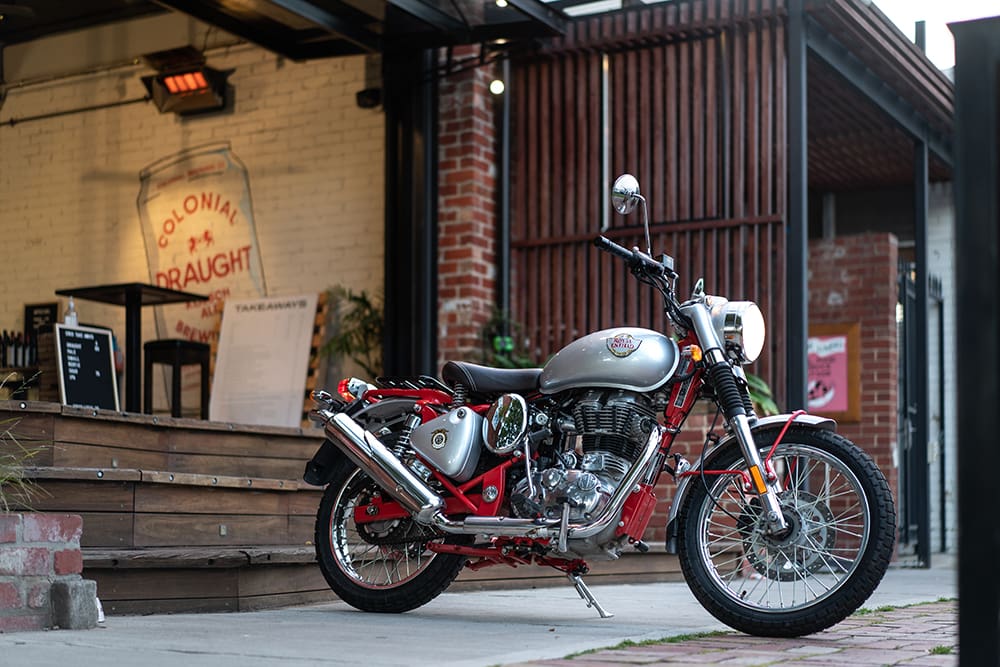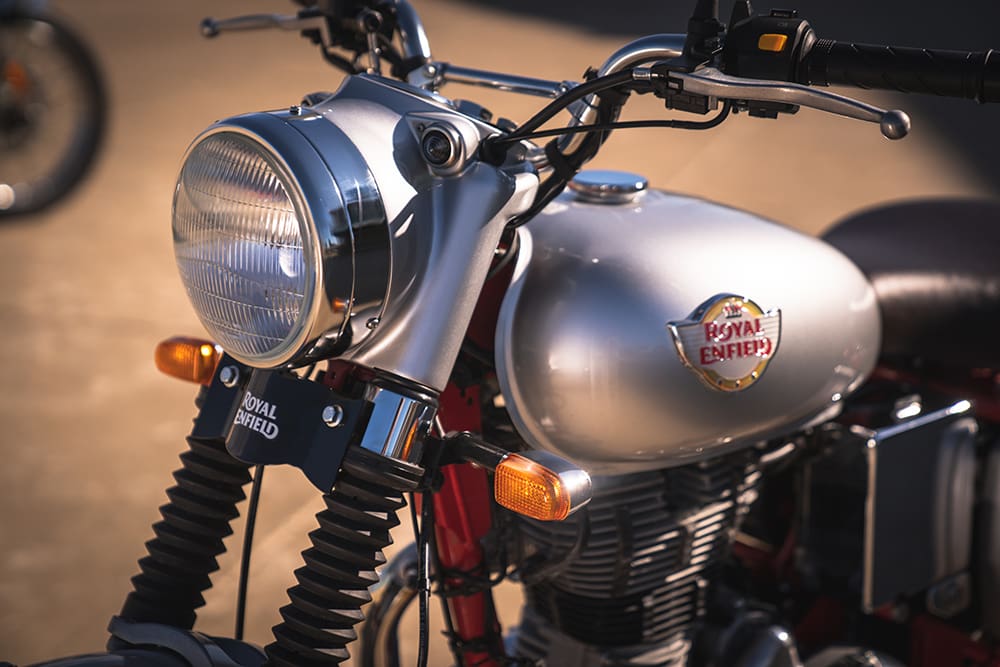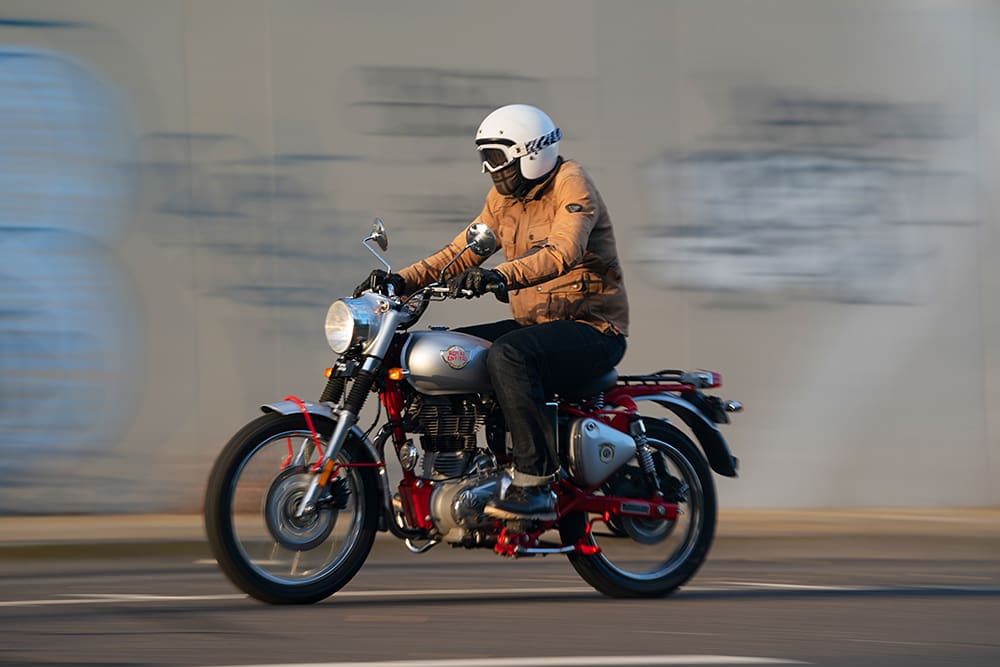It might be old and flawed against anything modern, but there’s still something charming, disarming and genuinely appealing about Royal Enfield’s Trials Works Replica
Test Chris Harris Photography BG Photography
Royal Enfield’s classic singles aren’t for everybody, and that’s very much part of their appeal. Take the Bullet 500, for example. With the title of longest production run of any motorcycle, the Bullet has been unashamedly rudimentary for almost a century – and it’s still with us essentially unchanged – so of course it’s old and flawed against anything modern. But that’s not its reason for being now, is it?
A distilled explanation could perhaps be akin to riding a piece of motorcycling history where comparative flaws become charms. Rugged, simple and honest, it’ll happily chug along all day encouraging you to short shift your modern mindset from speed to tweed. Do that and just try not to smile.

Turns out not everybody seeks envelope-pushing performance and technology in their motorcycle, which explains the Indian brand’s recent resurgence in the western world. People are going back to basics.
Now we have the final shipment of the Classic 500 Trials Works Replica, a limited-edition model based on the Bullet 500 with a rideaway price of $9190. As its name suggests, the Trials Works Replica is no Toni Bou-esque competition rock-hopper. In fact, differences from the regular Bullet 500 are purely aesthetic, with touches of added ruggedness, an upswept exhaust, a rear rack replacing a pillion perch and the choice of a red or green frame for an overall look to mimic its spiritual predecessors. The closest it gets to the balanced world of trials are in its name and Ceat-branded universal trials tyres.

So what you’re looking at here is a tribute model that pays homage to Royal Enfield’s dominance at the Scottish and International Six Day Trial competitions between 1948 and 1953. The only differences with today’s iteration is the inclusion of EFI and Euro-4 emissions compliance, a disc brake up front and ABS, electric start (there’s still a kickstarter) and laws stipulating the wearing of an approved motorcycle helmet instead of a pudding bowl or a Peaky Blinders-style flat cap and goggles. Other than that, she’s pretty much the same machine the late Johnny Brittain rode to countless victories (see sidebar).
The Trials Works Replica is the same as the regular Bullet 500, too. Ergonomics haven’t been modified to suit the technical off-road discipline and its conventional-sized, rubber-wrapped footpegs (which also happen to be inconveniently fixed, not spring-loaded) haven’t been replaced by larger, serrated items. Furthermore, the engine, chassis, suspension specification and 19/18-inch front/rear wheels are identical to the regular Classic 500’s.

From the moment you throw a leg over and oblige yourself to the auld dear’s hospitable spring-loaded solo saddle, there’s a strong sense of sentimentality (or familiarity if you’ve had more birthdays than you’d like). For me, riding a Bullet 500 reminds me of my ancestry. I feel like I slip into my Burmese grandfather’s boots during his years in the British Army against the Japanese, putting along the Thai-Burmese border astride his trusty Royal Enfield. I think of him, then a young man, receiving telegrams informing him of the birth of another healthy baby (he had eight).
He’s no longer with us, so riding a single-cylinder Royal Enfield pays homage to him. It’s a nice feeling. Helping evoke the ancestral imagery are the Enfield’s neutral and traditional ergonomics, its unapologetic absence of speed and overall sense of honesty, all of which subtly suggest mechanical longevity. Everything about it is low-stress, especially that endearing air-cooled thumper, which kicks into life quickly and easily.

But it’s not an entirely rose-tinted affair. If you’re at all familiar with the riding experience of a Bullet 350 or 500 then you’ll know they’re more Massey Ferguson than MV Agusta. Your hands and feet buzz with vibrating numbness at speeds above 90km/h, the gear shift into first and hunt for Neutral can be similarly agricultural and, up close, the fit and finish errs on slap-dash. If you’re wondering, the factory can churn out 5000 units per day, or one bike every 52 seconds.
Stopping power is fine for the bike’s intended use, and the non-switchable Bosch two-channel ABS doesn’t intervene too early or pulse through the lever or pedal. Braking performance, now with a disc at each end (woo-hoo!), has been engineered to meet the demands of RE’s gargantuan domestic market, with a wooden feel at the front lever and a surprisingly effective rear, which apparently gets a good nudge in India. Ditto the horn.

As for performance, Rolls-Royce’s famous mantra comes to mind where horsepower outputs were quoted as “sufficient”. A gentleman needn’t seek more, and the exclusive marque didn’t like to quote a figure or brag about speed. Royal Enfield is no different, even if it’s at the opposite end of the performance spectrum. But that’s not to say the Classic Trials can’t cope with the cut and thrust of today’s testy traffic. “Sufficient” aptly describes the 192kg Enfield’s ability to take off from stationary cars or jump, nay, shimmy into a gap in peak-hour traffic. The key to convincing momentum is foregoing the thumper’s 20kW (27hp) at 5250rpm and short-shifting through the simple five-speeder to utilise the 41Nm of torque, which peaks at 4000rpm.
You can still show a clean pair of heels from distracted drivers if you must, but that’s not quite the etiquette of a Royal Enfield rider now, is it? It’s more enjoyable and stately for man and machine to amble along at 60-90km/h, nestling in the mechanical sweet spot. Top speed? About 130km/h or a bit more with a descent, a tailwind and a good gut full of curry from the night before.

In order to meet Euro-4 emissions standards, the 2018 models became a little smoother-running. This brought about an anti-fuel vapour system, which comprises a vapour vent pipe in the 13.5-litre fuel tank, a purge valve, canister and a throttle body with a purge port. The ensuing result was just enough to knock off some of the rougher edges without tranquillising its character or appeal.
So how does a bike that places a low priority on performance actually handle? Simply put, fine for its intended role. It’s straight away easy, comfortable and, once you get to know it, even entertaining at times knowing you’ve reached the bike’s limits, not your own.

That, right there, serves as a reminder that you don’t need the neddies to have pure, unadulterated fun. It’s back to basics, alright, and, for some, it’s enlightening. If it means anything to you, the 35mm forks offer 130mm travel while the twin rear shocks (with five-way preload adjustment) offer 80mm – the same as Enfield’s other classic models.
It’s easy to shun a Royal Enfield for everything it lacks, but that would be missing the point and why they remain an acquired taste in the western world. Sure, a bit more curry wouldn’t go astray but, for similar reasons why many of us enjoy older bikes, there’s something honest and endearing about putting along at a more relaxed pace, taking in the generous serving of charm and nostalgia with the sun on your back. With a mindset shifted from speed to tweed, just try not to smile.
